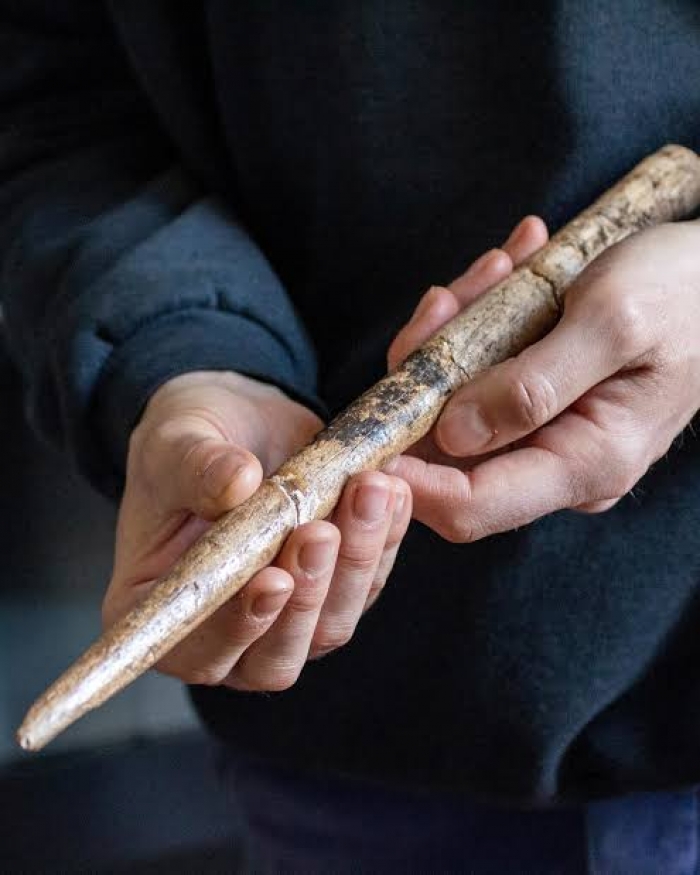Artifacts found at archeological sites in France and Spain along the Bay of Biscay shoreline show that humans have been crafting tools from whale bones since more than 20,000 years ago, illustrating anew the resourcefulness of prehistoric people.
The tools, primarily hunting implements such as projectile points, were fashioned from the bones of at least five species of large whales, the researchers said. Bones from sperm whales were the most abundant, followed by fin whales, gray whales, right or bowhead whales - two species indistinguishable with the analytical method used in the study - and blue whales.
With seafaring capabilities by humans not developing until thousands of years later, the Ice Age hunter-gatherers who made these implements would have been unable to actually hunt whales for their resources in the Bay of Biscay, a gulf of the Atlantic Ocean.
"These whales were likely opportunistically acquired from stranded animals or drifted carcasses, rather than actively hunted," said biomolecular archaeologist Krista McGrath of the Autonomous University of Barcelona, co-lead author of the study published in the journal Nature Communications.
"The majority of the bones were identified from offshore, deep-water species - such as sperm whale and fin whale - which would have been very difficult to hunt for these prehistoric groups. And there is no evidence from this time period that they had the level of technology that active hunting would have required, like seafaring boats," McGrath said.
The 71 whale bone artifacts analyzed by the researchers were found at 27 cave or rock shelter sites. The two oldest ones, both from the bones of fin whales, came from the Spanish Cantabrian sites of Rascaño, dating to about 20,500 years ago, and El Juyo, dating to about 19,800 years ago.
The rough age range of the artifacts was from 14,000 years old to more than 20,000 years old, but most were 16,000 to 17,500 years old.
The main raw material used to manufacture spear points at the time was antler from reindeer or red deer because it is less brittle and more pliable than land mammal bone. But whale bone offered some advantages, including its large dimensions, with some of the projectile points measuring more than 16 inches (40 cm) long, a size difficult to achieve using antler.
"They can be very long and thick, and were probably hafted on spear-style projectiles rather than arrows. They are usually found as fragments, many of which bear fractures related to use, and they were most likely used to hunt the main game animals of the time - reindeer and red deer, horse, bison and ibex," said archaeologist and study co-senior author Jean-Marc Pétillon of the French National Centre for Scientific Research.
Bone tools were used by members of the human evolutionary lineage dating back far before our species Homo sapiens emerged more than 300,000 years ago in Africa. The artifacts examined in this study pushed back the oldest-known use of whale bones for toolmaking by 1,000 to 2,000 years.
The objects were previously discovered at the various sites and kept in museum collections. The researchers used modern analytical techniques to determine the species from which the bones came and the age of the artifacts.
Humans living in this period of prehistory generally were inland hunters, obtaining most of their subsistence needs from the hunting of large hoofed mammals, Pétillon said. The new findings enhance the understanding of their exploitation of seashore resources, Pétillon added.
Previous research had shown that Ice Age people gathered seashells, hunted seabirds and fished for marine fishes as a complement to meat from terrestrial animals.
"The new findings tell us that these prehistoric groups were likely very well adapted to these coastal environments, and very likely had deep local ecological knowledge and understanding of their coastal habitats," McGrath said.
"Whale bones would have been for more than just making tools. There is evidence for their use as fuel as well - the bones contain large amounts of oil - among other things. And the rest of the whale would also certainly have been used – teeth or baleen depending on the species, meat, skin. A single whale provides a lot of resources," McGrath said.
Reuters


































































